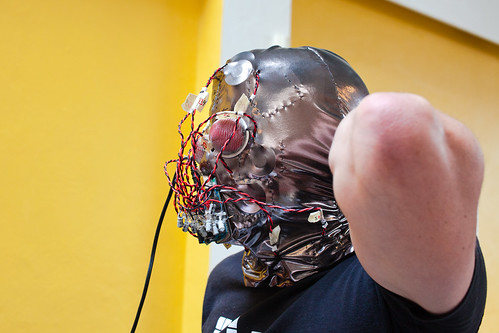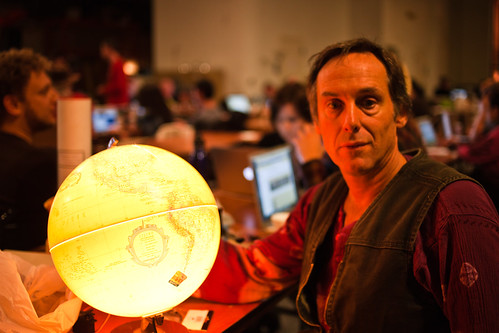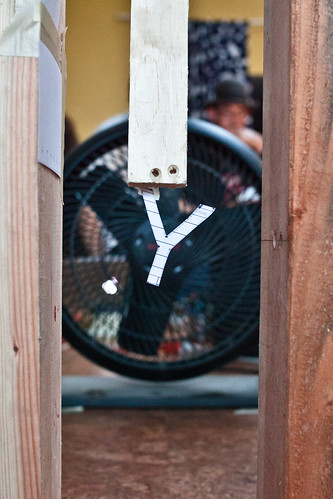 Mission control, Science Hack Day SF (photo by Matt Biddulph)
Mission control, Science Hack Day SF (photo by Matt Biddulph)
It’s been a little over a week since the second Science Hack Day SF took place at Brightworks. The event this year was an even larger success – hosting 150 science hackers from the local area and countries around the world, including: Brazil, Canada, Germany, Iceland, Ireland, Japan, Kenya, Mexico, and South Africa. The awesomeness of the people and the hacks that come together via Science Hack Day is difficult to put into words, but here are a few: overwhelming, unexpected, joyful, serendipitous, amazing and fun.
The event kicked off with a variety of lightning talks around data, tools and ideas to consider using throughout the weekend. The talks covered a wide variety of scientific exploration: NASA data, cognitive science experiments, DIY underwater exploration, citizen science data, geophysical gadgets, science tinkering for kids, DIYbio endeavors, data visualization, and data from the Large Hadron Collider.
The science hacking went straight through Saturday morning into Sunday – many hacking until 4am and a few working through the night with no sleep (check out the time-lapse video of the event!). Sunday afternoon, at 13:37, all hands were ordered off keyboards and robots, as hacking officially ended and demos began. The result of 24 consecutive hours of tinkering was 26 different hacks across a very wide spectrum of science.
The hacks
Browse the entire list of hacks from Science Hack Day SF 2011 or watch a video of the hack demos. We awarded engraved SCIENCE medals to the winning teams of 6 competition categories:
People’s Choice: Syneseizure!

(photo by Matt Biddulph)
From the team: “Synesthesia is a condition in which one sensation (sight, hearing, etc) gets mixed up with another. This can cause situations in which someone “smells” sounds, or “sees” touches. For this hack, we designed and built a full head mask that allows the wearer to feel images in real time. The mask is arrayed with 12 speakers that contact the skin of the face. When an image is captured with a webcam and converted into a 12 pixel black-and-white representation. The computer activates arduinos that control the speakers. If the pixel is white, the corresponding speaker is turned on. If the pixel is black, the corresponding speaker is turned off. This allows the wearer to feel (via the vibrations of the speakers) on their face.”
More on the hack can be found at: http://syneseizure.wordpress.com/ and a video of the demo at: http://youtube.com/watch?v=BhmfGMqn-8o
Best In Show: DNAquiri

(photo by Matt Biddulph)
From the team: “We developed a DNA extraction protocol, the product of which also happens to be a tasty cocktail. Fruit cells (strawberry and others) are lysed by freeze/thaw and heat cycles to eliminate the use of surfactants. Salt is minimized and sugar added in order to mask any salty flavor. Bacardi 151 is layered over fruit purée to extract DNA into the ethanol phase. A tiny umbrella completes the tropical vibe.”
Check out how to do-it-yourself at: http://instructables.com/id/DNAquiri-the-delicious-DNA-extraction/
The Data Award: EpiCell

From the team: “Background: Disease is prevalent but healthcare is not. However, much of the world now has access to a cell phone. Technologies are being developed that can turn cell phones into diagnostic devices. These devices can be used at the point of care and the information can be transmitted in real-time to experts and databases. If properly deployed and used, mobile diagnostic devices could facilitate addressing the needs of individuals in impoverished areas and tracking the emergence of disease outbreaks. Hack: To determine where such devices should be deployed, we collected open source geospatial data and created a map to identify locations where healthcare was scarce, but cell phone coverage was readily available.”
See the hack in action: http://epicell.github.com/
The Brightworks Hardware Award: ISS Globe

(photo by Matt Biddulph)
From the team: “The position of the International Space Station in real time drawn on a physical globe with a laser pointer. We took an vintage globe and two hobby servos and a laser and mounted the laser on the inside of the [translucent] globe such that the laser could be pointed at any point on Earth. Firmware was written as an interface between the servos and a laptop. A python client was written to talk to the microcontroller (a teensy) controlling the servos and place the laser dot on Earth where the ISS is in real time.”
View the ISS Globe in action: http://yfrog.com/h74c0qjj
The Design Award: Isodrag Typeface

(photo by Matt Biddulph)
From the team: “Most typefaces look for visual consistency in their design but what about physical consistency? In this hack, the aerodynamic properties of letters were determined in a home-made wind tunnel experiment and then those letters were rescaled so that all letter have approximately the same aerodynamic drag. For example, the letter “I” has low aerodynamic drag normally so it becomes much thicker in the isodrag typeface. Conversely, “W” has significant drag so it becomes thinner than usual.”
View the resulting typeface: http://twitpic.com/7dpbrd
The DTRA Government Award: Quake Canary “PEEPS”

(photo by Satoka F.)
From the team: “Basically, the concept is: 1) We’re using accelerometer data from arduinos and iphones and geophones to act as a notification of an earthquake. 2) We collect this publically-contributed seismic data and publish it to a online map using openheatmap.com. 3) We compare with USGS and other seismic data available to the public in real time – also added to our map. 4) We notify users of a recent or pending earthquake using an iphone app.”
More coverage
• Tweets from #sciencehackday
• Photos from the event by Matt Biddulph, Ariel Waldman, Brightworks, and Satoka
• Extensive summary by the great OpenGov team at NASA who hacked the weekend away
• An attendee’s experience who was part of the Syneseizure hack team
Many thanks
Science Hack Day is only made possible thanks to each uniquely awesome person that attends – so first and foremost, thank you to everyone who attended and created such an open, welcoming and collaborative community. Additional thanks to the Alfred P. Sloan Foundation that awarded a grant allowing 10 people from around the world who are interested in organizing a Science Hack Day in their city to attend Science Hack Day SF.
Many thanks to our amazing sponsors who help keep the event completely free to attend and support the sheltering and nourishment for all our hackers. We encourage you to learn more about each of the sponsors at their following links:
Nobelists: Brightworks, Defense Threat Reduction Agency
Fellows: GitHub, Bay Area Science Festival, Galleria Park Hotel, CartoDB, Mendeley
Scholars: swissnex san francisco, Public Library of Science, Mozilla WebFWD, Silicon Valley Space Center
More thanks to the Science Hack Day SF co-organizing team who help advise and coordinate the event with me throughout the year: Arfon Smith, Ariel Waldman, David Harris, Ed Gutman, Eri Gentry, Ian Fung, Jeremy Keith, Jessy Schingler, Kirsten “Dr. Kiki” Sanford, Kishore Hari, Mathias Crawford, Matt Biddulph, Matt Hancher, Matt Wood, Paul Mison and Tantek Çelik. We all volunteer our time for several months out of the year to help make the 48 hours of Science Hack Day as awesome as possible.
– Ariel Waldman, Science Hack Day SF lead organizer
1 Comment
Ryan · November 22, 2011 at 10:49 pm
Yay! Science Hack Day was awesome!
Comments are closed.